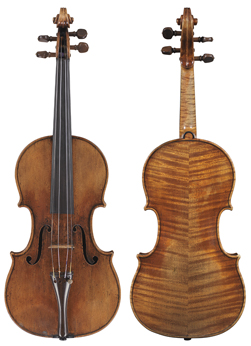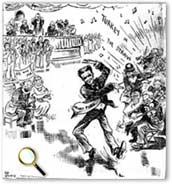| |
February 1999 |

Violin: Made by Antonio Stradivari of Cremona, Italy
Date: 1703
ID: 33.250.2
Antonio Stradivari (ca. 1645-1737) is the most famed of classical violinmakers. The innovative Stradivari created exquisitely constructed instruments that produce a rich and expressive tone. Many violinmakers since Stradivari's time have attempted to duplicate the unforgettable sound of a Stradivarius violin. |
This Stradivari violin, made in 1703, is one of several fine 17th and 18th century violins purchased by Henry Ford during the mid-1920s. Henry Ford had a special fondness for the "fiddle" and-as one of the wealthiest men in the world--could indulge his passion by acquiring a number of fine instruments like this Stradivari violin. Although--much to his chagrin--Ford never learned to fiddle very well, he would often play for hours in his private laboratory on one of the classical violins he owned.
During this time, Henry Ford led a nationwide revival of interest in country fiddling and old-fashioned dancing, which swept the country in 1925 and 1926. Ford sponsored fiddling contests between country fiddlers, offering the "Henry Ford Gold Cup" as a prize in a well-publicized Detroit contest. Contests were also held in hundreds of other communities, with Ford offering a loving cup to many of the winners.
Henry Ford organized an "Old Time Orchestra" to provide music as Benjamin Lovett, a dancing master brought from Massachusetts, taught Ford's friends and business associates as well as the local schoolchildren the Virginia reel, schottische, varsovienne and waltz. Henry Ford invited 200 Ohio and Michigan dance instructors to learn these nearly forgotten steps which had been popular in his youth. He also arranged for his orchestra to play old-fashioned dance music over a nationwide network of radio stations during the public introduction of the new Ford automobiles in January of 1926 and 1927. Hundreds of dealers across the country set up loudspeakers in their showrooms and invited townspeople to dance to the music. Old-fashioned dancing quickly became the rage throughout the country.
 |
This cartoon, published in 1926 in the Des Moines Register, captures Henry Ford's unbridled enthusiasm for the country fiddlers and traditional music of his youth.
ID: P.D.856
 Listen to the music (357K) Listen to the music (357K)
|
While popular enthusiasm for these traditional American entertainments waned
by the spring of 1926, Ford continued to hold old-fashioned dance
parties in Dearborn until the 1940s. Since Ford's time, his classical
violins have been exhibited at the Henry Ford Museum and have been
played occasionally at concerts of classical music. Traditional American dances are still held at the Henry Ford Museum in an elegant ballroom named for Benjamin Lovett, Ford's dancing master.
[ Pic of the Month ] [ Pic Archive ] |

